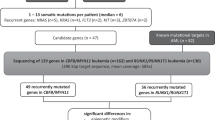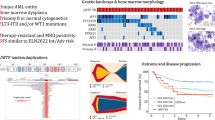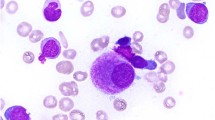Abstract
In a 5-year survey of nonpromyelocytic/nonmonocytic acute myeloid leukemias (AMLs) diagnosed in the University of Washington Hematopathology Laboratory, we identified 19 cases containing distinctive, cup-like nuclear indentation in 10% or more of the blasts (‘AML-cuplike’). Fourteen of these cases (74%) demonstrated near-complete loss of HLA-DR expression, while the other five cases showed partial loss of HLA-DR. A total of 16 of the cases (84%) demonstrated internal tandem duplication (ITD) of the Flt3 gene. When compared to a selected set of AMLs lacking this nuclear morphology, AML-cuplike was significantly more likely to lack HLA-DR and CD34 expression, to express CD123 without CD133, to have a normal karyotype, and to harbor the Flt3 ITD. To characterize AML-cuplike in an unselected series of AMLs, we analyzed 42 consecutive nonpromyelocytic/nonmonocytic AMLs diagnosed in our laboratory during a 6-month period in 2002. Strikingly, in this unselected series, there was a statistically significant coincidence of invaginated nuclear morphology, loss of HLA-DR, and presence of the Flt3 ITD beyond that expected if these three features were unrelated, suggesting that AMLs with these three features may represent a distinct AML subset.
This is a preview of subscription content, access via your institution
Access options
Subscribe to this journal
Receive 12 print issues and online access
$259.00 per year
only $21.58 per issue
Buy this article
- Purchase on Springer Link
- Instant access to full article PDF
Prices may be subject to local taxes which are calculated during checkout



Similar content being viewed by others
References
Jaffe ES, Harris NL, Stein H, Vardiman JW . WHO Classification of Tumours: Pathology and Genetics of Tumours of the Haematopoietic and Lymphoid Tissues. IARC Press: Lyon, 2001.
Gilliland DG, Griffin JD . The roles of FLT3 in hematopoiesis and leukemia. Blood 2002; 100: 1532–1542.
Stirewalt DL, Radich JP . The role of FLT3 in haematopoietic malignancies. NatRev Cancer 2003; 3: 650–665.
Nakao M, Yokota S, Iwai T, Kaneko H, Horiike S, Kashima K et al. Internal tandem duplication of the Flt3 gene found in acute myeloid leukemia. Leukemia 1996; 10: 1911–1918.
Kiyoi H, Towatari M, Yokota S, Hamaguchi M, Ohno R, Saito H et al. Internal tandem duplication of the FLT3 gene is a novel modality of elongation mutation which causes constitutive activation of the product. Leukemia 1998; 12: 1333–1337.
Hayakawa F, Towatari M, Kiyoi H, Tanimoto M, Kitamura T, Saito H et al. Tandem-duplicated Flt3 constitutively activates STAT5 and MAP kinase and introduces autonomous cell growth in IL-3-dependent cell lines. Oncogene 2000; 19: 624–631.
Schnittger S, Schoch C, Dugas M, Kern W, Staib P, Wuchter C et al. Analysis of FLT3 length mutations in 1003 patients with acute myeloid leukemia: correlation to cytogenetics, FAB subtype, and prognosis in the AMLCG study and usefulness as a marker for the detection of minimal residual disease. Blood 2002; 100: 59–66.
Thiede C, Steudel C, Mohr B, Schaich M, Schakel U, Platzbecker U et al. Analysis of FLT3-activating mutations in 979 patients with acute myelogenous leukemia: association with FAB subtypes and identification of subgroups with poor prognosis. Blood 2002; 99: 4326–4335.
Kiyoi H, Naoe T, Nakano Y, Yokota S, Minami S, Miyawaki S et al. Prognostic implication of FLT3 and N-RAS gene mutations in acute myeloid leukemia. Blood 1999; 93: 3074–3080.
Rombouts WJ, Blokland I, Lowenberg B, Ploemacher RE . Biological characteristics and prognosis of adult acute myeloid leukemia with internal tandem duplications in the Flt3 gene. Leukemia 2000; 14: 675–683.
Kottaridis PD, Gale RE, Frew ME, Harrison G, Langabeer SE, Belton AA et al. The presence of a FLT3 internal tandem duplication in patients with acute myeloid leukemia (AML) adds important prognostic information to cytogenetic risk group and response to the first cycle of chemotherapy: analysis of 854 patients from the United Kingdom Medical Research Council AML 10 and 12 trials. Blood 2001; 98: 1752–1759.
Moreno I, Martin G, Bolufer P, Barragan E, Rueda E, Roman J et al. Incidence and prognostic value of FLT3 internal tandem duplication and D835 mutations in acute myeloid leukemia. Haematologica 2003; 88: 19–24.
Iwai T, Yokota S, Nakao M, Okamoto T, Taniwaki M, Onodera N et al. Internal tandem duplication of the FLT3 gene and clinical evaluation in childhood acute myeloid leukemia. The Children's Cancer and Leukemia Study Group, Japan. Leukemia 1999; 13: 38–43.
Meshinchi S, Woods WG, Stirewalt DL, Sweetser DA, Buckley JD, Tjoa TK et al. Prevalence and prognostic significance of Flt3 internal tandem duplication in pediatric acute myeloid leukemia. Blood 2001; 97: 89–94.
Whitman SP, Archer KJ, Feng L, Baldus C, Becknell B, Carlson BD et al. Absence of the wild-type allele predicts poor prognosis in adult de novo acute myeloid leukemia with normal cytogenetics and the internal tandem duplication of FLT3: a cancer and leukemia group B study. Cancer Res 2001; 61: 7233–7239.
Stirewalt DL, Kopecky KJ, Meshinchi S, Appelbaum FR, Slovak ML, Willman CL et al. FLT3, RAS, and TP53 mutations in elderly patients with acute myeloid leukemia. Blood 2001; 97: 3589–3595.
Kussick SJ, Wood BL . Using four-color flow cytometry to identify abnormal myeloid populations. Arch Pathol Lab Med 2003; 127: 1140–1147.
Stirewalt DL, Meshinchi S, Kussick SJ, Sheets KM, Pogosova-Agadjanyan E, Willman CL et al. Novel FLT3 point mutations within exon 14 found in patients with acute myeloid leukaemia. Br J Hematol 2004; 124: 481–484.
Seabright M . A rapid banding technique for human chromosomes. Lancet 1971; 2: 971–972.
Radich JP, Gehly G, Gooley T, Bryant E, Clift RA, Collins S et al. Polymerase chain reaction detection of the BCR-ABL fusion transcript after allogeneic marrow transplantation for chronic myeloid leukemia: results and implications in 346 patients. Blood 1995; 85: 2632–2638.
Borrow J, Goddard AD, Gibbons B, Katz F, Swirsky D, Fioretos T et al. Diagnosis of acute promyelocytic leukaemia by RT-PCR: detection of PML-RARA and RARA-PML fusion transcripts. Br J Haematol 1992; 82: 529–540.
Wetzler M, McElwain BK, Stewart CC, Blumenson L, Mortazavi A, Ford LA et al. HLA-DR antigen-negative acute myeloid leukemia. Leukemia 2003; 17: 707–715.
Munoz L, Aventin A, Villamor N, Junca J, Acebedo G, Domingo A et al. Immunophenotypic findings in acute myeloid leukemia with FLT3 internal tandem duplication. Haematologica 2003; 88: 637–645.
Noguera NI, Breccia M, Divona M, Diverio D, Costa V, De Santis S et al. Alterations of the FLT3 gene in acute promyelocytic leukemia: association with diagnostic characteristics and analysis of clinical outcome in patients treated with the Italian AIDA protocol. Leukemia 2002; 16: 2185–2189.
Arrigoni P, Beretta C, Silvestri D, Rossi V, Rizzari C, Valsecchi MG et al. FLT3 internal tandem duplication in childhood acute myeloid leukaemia: association with hyperleucocytosis in acute promyelocytic leukaemia. Br J Haematol 2003; 120: 89–92.
Shih LY, Kuo MC, Liang DC, Huang CF, Lin TL, Wu JH et al. Internal tandem duplication and Asp835 mutations of the FMS-like tyrosine kinase 3 (FLT3) gene in acute promyelocytic leukemia. Cancer 2003; 98: 1206–1216.
Acknowledgements
We thank the technical staff of the University of Washington Hematopathology Laboratory for outstanding help in the flow cytometric evaluation of all the cases in this series, and for the cryopreservation and maintenance of a number of the cases in this series. We thank the technical staff of the University of Washington Molecular Hematology Laboratory for assistance in developing the FLT3 ITD assay on the ABI 310. We thank Dr Tony Rossini of the University of Washington Department of Medical Education and Biomedical Informatics for statistical advice.This study was supported by grants K23 CA92405 and CA18029 from the National Institutes of Health and National Cancer Institute.
Author information
Authors and Affiliations
Corresponding author
Rights and permissions
About this article
Cite this article
Kussick, S., Stirewalt, D., Yi, H. et al. A distinctive nuclear morphology in acute myeloid leukemia is strongly associated with loss of HLA-DR expression and FLT3 internal tandem duplication. Leukemia 18, 1591–1598 (2004). https://doi.org/10.1038/sj.leu.2403458
Received:
Accepted:
Published:
Issue Date:
DOI: https://doi.org/10.1038/sj.leu.2403458
Keywords
This article is cited by
-
Conversion from nuclear bilobation to indentation in BCR/ABL1-positive acute myeloid leukemia lacking CD34 and HLA-DR expression
Annals of Hematology (2015)
-
Clinical features of De Novo acute myeloid leukemia with concurrent DNMT3A, FLT3 and NPM1 mutations
Journal of Hematology & Oncology (2014)
-
Association of cup-like nuclei in blasts with FLT3 and NPM1 mutations in acute myeloid leukemia
Annals of Hematology (2013)
-
Elevated frequencies of leukemic myeloid and plasmacytoid dendritic cells in acute myeloid leukemia with the FLT3 internal tandem duplication
Annals of Hematology (2011)



